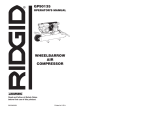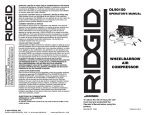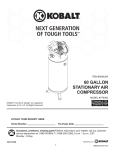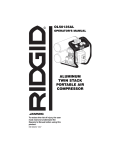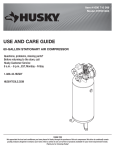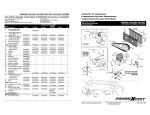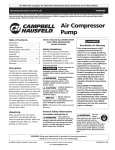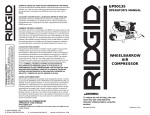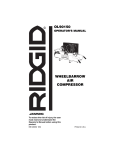Download RIDGID GP90150A Operator`s manual
Transcript
GP90150A OPERATOR’S MANUAL WHEELBARROW AIR COMPRESSOR To reduce the risk of injury, the user must read and understand the Operator’s Manual before using this product. IN629100AV 12/08 Printed in U.S.A. Table of Contents Section Page Section Table of Contents . . . . . . . . . . . . . . . .2 Page Maintenance . . . . . . . . . . . . . . . . . . .13 Maintenance Schedule . . . . . . . . . .13 Tank . . . . . . . . . . . . . . . . . . . . . . . . .14 Filter Removal, Inspection, and Replacement . . . . . . . . . . . . . . . . . .14 Drive Belt . . . . . . . . . . . . . . . . . . . . .15 Storage . . . . . . . . . . . . . . . . . . . . . .15 Safety Instructions . . . . . . . . . . . . . . .3 Safety Signal Words . . . . . . . . . . . . .3 Before Using the Air Compressor . . . . . . . . . . . . . . . . . . . .3 Spraying Precautions . . . . . . . . . . . .5 Breathable Air Warning . . . . . . . . . . .5 Warning Labels . . . . . . . . . . . . . . . . .6 Troubleshooting . . . . . . . . . . . . . . . .16 Glossary of Terms . . . . . . . . . . . . . . .7 Notes . . . . . . . . . . . . . . . . . . . . . . . . .19 Unpacking and Checking Content . . . . . . . . . . . . . . . . . . . . . . . .7 Repair Parts . . . . . . . . . . . . . . . . . . .20 Getting to Know Your Air Compressor . . . . . . . . . . . . . . . . . . . .8 Warranty . . . . . . . . . . . . . . . . . . . . . .24 Notes . . . . . . . . . . . . . . . . . . . . . . . . .22 Operating Your Air Compressor . . .10 Moisture in Compressed Air . . . . . .10 Lubricaton . . . . . . . . . . . . . . . . . . . .11 Start-up . . . . . . . . . . . . . . . . . . . . . .11 To Start Gasoline Engine . . . . . . . .12 2 Safety Instructions This manual contains information that is very important to know and understand. This information is provided for SAFETY and to PREVENT EQUIPMENT PROBLEMS. To help recognize this information, observe the following symbols. Warning indicates a potentially hazardous situation which, if not avoided, COULD result in death or serious injury. Safety Signal Words Caution indicates a potentially hazardous situation which, if not avoided, MAY result in minor or moderate injury. Danger indicates an imminently hazardous situation which, if not avoided, WILL result in death or serious injury. Notice indicates important information, that if not followed, may cause damage to equipment. Before Using the Air Compressor 5. Wear safety glasses (meeting ANSI Z87.1 or in Canada CSA Z94.3-99) and use hearing protection when operating the pump or unit. Everyday glasses are not safety glasses. CALIFORNIA PROPOSITION 65 This product or its power cord may contain chemicals, including lead, known to the State of California to cause cancer and birth defects or other reproductive harm. Wash hands after handling. 6. Do not stand on or use the pump or unit as a handhold. 7. Before each use, inspect compressed air system, fuel system and electrical components for signs of damage, deterioration, weakness or leakage. Repair or replace defective items before using. Since the air compressor and other components (pump, spray guns, filters, lubricators, hoses, etc.) used make up a high pressure pumping system, the following safety precautions must be observed at all times: 8. Check all fasteners at frequent intervals for proper tightness. 1. Read all manuals included with this product carefully. Be thoroughly familiar with the controls and the proper use of the equipment. MANUAL Never operate compressor without a beltguard. Com-pressors can start automatically without warning. Personal injury or property damage could occur from contact with moving parts. 2. Follow all local safety codes as well as the United States Occupational Safety and Health Act (OSHA). 3. Only persons well acquainted with these rules of safe operation should be allowed to use the compressor. 9. Do not wear loose clothing or jewelry that will get caught in the moving parts of the unit. 4. Keep visitors away and NEVER allow children in the work area. 3 Safety Instructions (continued) Compressor parts may be hot even if the unit is stopped. Motors, electrical equipment and controls can cause electrical arcs that will ignite a flammable gas or vapor. Never operate or repair in or near a flammable gas or vapor. Never store flammable liquids or gases in the vicinity of the compressor. 10. Keep fingers away from a running compressor; fast moving and hot parts will cause injury and/or burns. 11. If the equipment should start to vibrate abnormally, STOP the engine/motor and check immediately for the cause. Vibration is generally a warning of trouble. Carbon monoxide can cause severe nausea, fainting or death. Do not operate unit inside a closed building or a poorly ventilated area. NEVER refuel a running or hot engine. Explosive fuel can cause fires and severe burns. Avoid overfilling fuel tank. 13. To reduce fire hazard, keep engine/motor exterior free of oil, solvent, or excessive grease. 12. Check fuel level before starting the engine. Do not fill the gas tank indoors. Wipe off any spilled gas before starting the engine. Never remove or attempt to adjust safety valve. Keep safety valve free from paint and other accumulations. Gasoline vapor is highly flammable. Refill outdoors or only in well ventilated areas. Do not store, spill or use gasoline near an open flame or heat devices such as a stove, furnace, or water heater, which utilize a pilot light, or any device that can create a spark. If gasoline is accidentally spilled, move unit away from the spill area and avoid creating any source of ignition until gasoline vapors have dissipated. 14. Do not tamper with governor setting on engine. Overspeeding the unit severely shortens engine life and may also be very hazardous. Never attempt to repair or modify a tank! Welding, drilling or any other modification will weaken the tank resulting in damage from rupture or explosion. Always replace worn or damaged tanks. 4 15. Tanks rust from moisture build-up, which weakens the tank. Make sure to drain tank daily and inspect periodically for unsafe conditions such as rust formation and corrosion. 17. STOP the engine whenever leaving the work area, before cleaning, making repairs or inspections. When cleaning, repairing or inspecting, make certain all moving parts have stopped. Disconnect the spark plug wire and keep the wire away from the plug to prevent accidental starting. 16. Fast moving air will stir up dust and debris which may be harmful. Release air slowly when draining moisture or depressurizing the compressor system. 18. Allow engine to cool before storing. Spraying Precautions 21. Do not direct paint or other sprayed material at the compressor. Locate compressor as far away from the spraying area as possible to minimize overspray accumulation on the compressor. Do not spray flammable materials in vicinity of open flame or near ignition sources including the compressor unit. 22. When spraying or cleaning with solvents or toxic chemicals, follow the instructions provided by the chemical manufacturer. 19. Do not smoke when spraying paint, insecticides, or other flammable substances. 20. Use a face mask/respirator when spraying and spray in a well ventilated area to prevent health and fire hazards. Breathable Air Warning This compressor/pump is not equipped and should not be used “as is” to supply breathing quality air. For any application of air for human consumption, the air compressor/pump will need to be fitted with suitable in-line safety and alarm equipment. This additional equipment is necessary to properly filter and purify the air to meet minimal specifications for Grade D breathing as described in Compressed Gas Association Commodity Specification G 7.1 - 1966, OSHA 29 CFR 1910. 134, and/or Canadian Standards Associations (CSA). DISCLAIMER OF WARRANTIES In the event the compressor is used for the purpose of breathing air application and proper in-line safety and alarm equipment is not simultaneously used, existing warranties shall be voided, and Campbell Hausfeld disclaims any liability whatsoever for any loss, personal injury or damage. 5 Safety Instructions (continued) Warning Labels Find and read all warning labels found on the air compressor shown below DK724100AV 10003 6 Glossary of Terms ASME Safety Valve A safety valve that automatically releases the air if the air receiver (tank) pressure exceeds the preset maximum. Air Tank Capacity The volume of air stored in the tank and available for immediate use. A large tank allows the intermittent use of an air tool with an air requirement higher than the compressor’s rated delivery. PSI (Pounds per Square Inch) Measurement of the pressure exerted by the force of the air. The actual psi output is measured by a pressure gauge on the compressor Regulator A control that adjusts the line pressure to the proper amount needed to operate spray guns and air tools. SCFM (Standard Cubic Feet per Minute) Sometimes called CFM (Cubic Feet per Minute). Measurement of air volume delivered by the compressor. Tank Pressure Gauge Indicates tank pressure in psi. Line Pressure Gauge Displays the current line pressures. It is regulated by the regulator knob. Air Delivery A combination of psi and SCFM. The air delivery required by a tool is stated as (number) SCFM at (number) psi. The combination of these figures determines what size unit is needed. Cut-in/Cut-off Pressure Specific psi at which a compressor starts and stops while refilling the air tank. Unpacking and Checking Contents 1. Remove the air compressor from the carton. 2. Place the compressor on a secure, stationary work surface and look it over carefully. For your own safety, never operate unit until all assembly steps are complete and until you have read and understood the entire operator’s manual. Do not operate unit if damaged during shipping, handling or use. Damage may result in bursting and cause injury or property damage. To reduce the risk of injury, if any parts are missing, do not attempt to assemble the air compressor until the missing parts are obtained and installed correctly. 7 Getting to Know Your Air Compressor 1 Beltguard 2 Air Filter 3 Dipstick/Oil Sight Glass 4 5 6 7 Unloader Air Storage Tank 9 8 Handles Tank Drain Valve Regulator Knob 10 Regulated Outlet Gauge Tank Pressure Gauge 11 12 ASME Safety Valve Air Outlet Fittings ridgid.com 1-800-474-3443 DK724300AV 0104 Model/Serial Number Decal 8 1. Belt Guard. The belt guard encloses the pulleys and drive belt. It protects the user from moving parts and directs cooling air to the compressor pump 8. Regulated Outlet Gauge. This gauge shows at-a-glance, air pressure at outlet. Air pressure is measured in pounds per square inch (PSI). Most tools have maximum pressure ratings. Never exceed the maximum pressure rating of the tool you are using. Be sure this gauge reads ZERO before changing air tools or disconnecting hose from outlet. 2. Air Filter. The air filter keeps dirt and debris from entering the compressor pump and reduces compressor noise. 3. Dipstick/Oil Sight Glass. The dipstick and oil sight glass both measure the oil level in the compressor pump. 9. Regulator Knob. This knob controls air pressure to an air operated tool or paint spray gun. Turning the knob clockwise increases air pressure at the outlet. Turning counterclockwise will lower air pressure at the outlet. Fully counterclockwise will shut off the flow of air completely. Your compressor may have either a dipstick or an oil sight glass. Dipstick Add Oil Max Low Fill Line Close Open Full Add Oil 4. Handles. Used to move the compressor. 10. Tank Pressure Gauge. Gauge shows pressure in air receiver indicating compressor is building pressure properly. 5. Tank Drain Valve. The tank drain valve allows moisture to be removed from the tank. NOTE: Each tank has its own tank drain valve. 11. ASME Safety Valve. This valve automatically releases air if the tank pressure exceeds the preset maximum. 6. Unloader. The unloader controls the engine rpm. When loaded, the engine will run at maximum operating speed and air will enter the tank. When unloaded, the engine will slow to an idle and air will vent to atmosphere. 12. Air Outlet Fittings. These fittings are 1/4” universal-style quick connect fittings and allow rapid tool changes. 7. Air Storage Tanks. The tanks store air for later use. 9 Operating Your Air Compressor Before starting the compressor, thoroughly read all component instruction manuals, especially the engine manual. Drain liquid from tank daily. All lubricated compressor pumps discharge some condensed water and oil with the compressed air. Install appropriate water/oil removal equipment and controls as necessary for the intended application. Do not attach air tools to open end of the hose until start-up is completed and unit checks OK. Failure to install appropriate water/oil removal equipment may result in damage to machinery or workpiece. Moisture in Compressed Air Moisture in compressed air will form into droplets as it comes from an air compressor pump. When humidity is high or when a compressor is in continuous use for an extended period of time, this moisture will collect in the tank. When using a paint spray or sandblast gun, this water will be carried from the tank through the hose, and out of the gun as droplets mixed with the spray material. 10 IMPORTANT: This condensation will cause water spots in a paint job, especially when spraying other than water based paints. If sandblasting, it will cause the sand to cake and clog the gun, rendering it ineffective. A filter in the air line, located as near to the gun as possible, will help eliminate this moisture. Lubrication This compressor is shipped with oil. Dipstick Use single viscosity, ISO 100 (SAE 30), non-detergent compressor oil; or Mobil 1® 5W30 or 10W30 synthetic oil may also be used. See illustration for proper oil fill. Add Oil Max Low Refer to engine manual for proper oil level and type. Fill Line Full Add Oil Start-Up To ensure proper operation, unit must be on a level surface. 1. Fill engine with oil and gasoline per instructions furnished with engine. 2. Remove the compressor dipstick breather or check oil sight glass to verify proper oil level. 3. Turn manual unloader lever up to a horizontal position to allow the compressor pump to run without compressing air. Manual Unloader Lever in the Unloaded Position 11 Operating Your Air Compressor (continued) To Start Gasoline Engine 4. Move the choke lever to the CHOKE position, turn the fuel lever ON, and turn the engine stop switch to the ON position. 5. Pull start grip lightly until resistance is felt, and then pull briskly. 6. As the engine warms up, gradually move the choke lever to the open position. See gas engine manual for more details. 7. Run the compressor unloaded for approximately 30 minutes to break in the pump. 8. After approximately 30 minutes, move the unloader lever down to the loaded position. The compressor will begin to pump air into the tank. When maximum tank pressure is reached, the compressor automatically unloads, bringing the engine to idle. The engine remains at idle until tank pressure falls to a preset level. The engine then accelerates and the compressor pumps additional air into the tank. Manual Unloader Lever in the Loaded Position 12 Maintenance Release all pressure from the system before attempting to install, service, relocate or perform any maintenance. Do not attempt to tamper with the ASME safety valve! In order to maintain efficient operation of the compressor system, check the air filter weekly (per maintenance schedule), oil level and gasoline level before each use. The ASME safety valve should also be checked weekly. Pull ring on safety valve and allow the ring to snap back to normal position. This valve automatically releases air if the tank pressure exceeds the preset maximum. If air leaks after the ring has been released, or the valve is stuck and cannot be actuated by the ring, the ASME safety valve MUST be replaced. With engine OFF, clean debris from engine, flywheel, tank, air lines and pump cooling fins. Maintenance Schedule Operation Check Oil Level Drain Tank Daily l l Check Air Filter Weekly Monthly 3 Months l l Check Safety Valve l Blow Dirt From Unit Check Belt Tightness Change Oil 13 l l Maintenance (continued) Tank Never attempt to repair or modify a tank! Welding, drilling or any other modification will weaken the tank resulting in damage from rupture or explosion. Always replace worn, cracked or damaged tanks. Tank Drain (2) Drain liquid from tanks daily. The tanks should be carefully inspected at a minimum of once a year. Look for cracks forming near the welds. If a crack is detected, remove pressure from tank immediately and replace. Filter Removal, Inspection and Replacement To change a filter, pull off the filter housing cover. If filter element is dirty, replace element or entire filter. 14 Drive Belt Belt stretch is a result of normal use. When properly adjusted, the belt deflects about 1/2” with five pounds of pressure applied midway between the engine pulley and pump. 1/2” Deflection To adjust drive belt tension: 1. Remove belt guard and loosen engine brace. 2. Loosen the four fasteners holding the engine to the baseplate. 3. Shift the engine in the proper direction. The belt must be properly aligned when adjustment is made. 4. To align belt, lay a straight edge against the face of the flywheel, touching the rim at two places. 5. Adjust flywheel or engine pulley so that the belt runs parallel to the straight edge. 6. Use a gear puller to move the pulley on the shaft and tighten fasteners. 7. Adjust brace and reinstall belt guard. Belt Straight Edge Touch Rim of Flywheel in Two Places Straight Edge Parallel With Belt Storage 1. When not in use, hose and compressor should be stored in a cool, dry place. 2. Tanks should be drained of moisture. 3. Hose should be disconnected and hung with open ends down to allow any moisture to drain. 15 Troubleshooting For your own safety do not try and run the air compressor while troubleshooting. TROUBLE Low discharge pressure PROBABLE CAUSE 1. Air leaks 2. Leaking valves 3. Restricted air intake 4. Slipping belts 5. Blown gaskets 6. Low compression 16 REMEDY 1. Listen for escaping air. Apply soap solution to all fittings and connections. Bubbles will appear at points of leakage. Tighten or replace leaking fittings or connections 2. Remove head and inspect for valve breakage, weak valves, scored valve seats, etc. Replace defective parts and reassemble. Be sure that the old head gasket is replaced with a new one each time the head is removed 3. Clean the air filter element 4. Loosen engine clamping bolts and move the engine in a direction away from the compressor, being sure that the engine pulley is perfectly aligned with the flywheel. Tighten engine clamping bolts. The belt should deflect about 1/2” under 5lbs of force. Do not “roll” belts over pulleys 5. Replace any gaskets proven faulty on inspection 6. Low pressure can be due to worn rings and cylinder walls. Correction is made by replacing the rings, cylinders, and pistons as required TROUBLE Overheating PROBABLE CAUSE 1. Poor ventilation 2. Dirty cooling surfaces Excessive belt wear 1. Pulley out of alignment 2. Belt too loose or too tight 3. Belt slipping 4. Pulley wobbles Unit stalls 1. Low engine idle 2. Improper lubrication 3. Low oil level 4. Defective unloader valve Excessive noise (knocking) 1. Loose engine or compressor pulley 2. Lack of oil in crankcase 3. Worn connecting rod 4. Worn piston pin bushing 17 REMEDY 1. Relocate the compressor to an area where an ample supply of cool, clean, dry and well-circulated air is available 2. Clean the cooling surfaces of pump and motor/engine 1. Realign engine pulley with compressor pulley 2. Adjust tension (See Drive Belt Section) 3. Adjust tension or replace belt (See Drive Belt Section) 4. Check for worn crankshaft, keyway or pulley bore resulting from running the compressor or motor with loose pulleys. Check for bent pulleys or bent crankshaft 1. Increase idle, refer to engine manual for details 2. See LUBRICATION, under Assembly 3. Check oil level. Fill if necessary 4. Replace 1. Loose engine or compressor pulleys are a very common cause of compressors knocking. Tighten pulley clamp bolts and set-screws 2. Check for proper oil level; if low, check for possible damage to bearings. Dirty oil can cause excessive wear 3. Replace connecting rod 4. Remove piston assemblies from the compressor and inspect for excess wear. Replace excessively worn piston pin or pistons, as required Troubleshooting TROUBLE Excessive noise (knocking) Continued PROBABLE CAUSE 5. Worn bearings 6. Piston hitting the valve plate 7. Noisy check valve Oil in the discharge air 1. Worn piston rings 2. Compressor air intake restricted 3. Restricted breather 4. Excessive oil in compressor 5. Wrong oil viscosity 6. Connecting rod out of alignment 18 REMEDY 5. Replace worn bearings and change oil 6. Remove the compressor head and valve plate and inspect for carbon deposits or other foreign matter on top of piston. Replace head and valve plate using new gasket 7. Replace 1. Replace with new rings 2. Clean filter. Check for other restrictions in the intake system 3. Clean and check breather for free operation 4. Drain down to full level 5. Use SAE 30 (ISO 100) non-detergent compressor oil 6. Replace rod Repair Parts 43 39 38 42 1 41 37 29 30 2 28 26 19 40 27 44 36 31 46 32 45 3 4 25 33 5 7 34 35 24 23 6 19 20 7 21 22 8 9 18 17 11 16 15 14 13 12 10 11 20 Repair Parts For Repair Parts, Call 1-800-4-RIDGID Please provide following information: -Model number -Serial number (if any) -Part description and number as shown in parts list Ref. No 1 2 3 4 5 6 7 8 9 10 11 12 13 14 15 16 17 18 19 20 21 22 23 24 25 26 27 28 29 30 31 32 33 34 35 36 37 38 39 40 41 42 43 44 45 46 Catalog Number 17993 — 18003 17703 — — — 17798 17783 18028 17913 17918 18033 17853 18038 18043 18048 18053 18058 — 17878 17873 17793 17773 18068 18073 18078 18083 18088 18093 18098 18103 18108 18113 18118 18123 20978 20983 22788 22793 20423 18113 20428 21003 21008 22783 Part Number BG220901AJ — BT023100AV WL026100AV k u u V-215106AV ST071626AV ST160002AV D-1403 ST073612AV AR053400OR ST158300AV ST116400AV AA021800AV ST073613AV WA005501AV CV006412AV ST171400AV GA016709AV HF203300AV WL024501AV GA016705AV VT470000AV ST186600AV PU015901AV PU015400AV KE000900AV ST012200AV BG208800AJ NG002502AV ST070625AV ST011200AV AL014000AV ST164100AV ST033500AV ST084704AV BG210000AV ST070674AV ST016000AV ST011200AV ST146001AV BG220400AV ST073278AV ST076829AV u 22098 REPAIR KITS VT273500AJ Tube kit * k Considered Wear Items Standard hardware item - available at your local hardware store * * * * * * * * * * * 21 Descriptons Belt guard assembly (includes 37-45) Setscrew (included in 27) Belt (4L510) Filter assembly Screw Nylon tube Elbow fitting ASME Safety valve Torx screw Handle grip Drain valve Plug Tank Rubber foot Screw Axle rod Plug 10" Pneumatic wheel Throttle control Throttle unloader Gauge, outlet Coupler Regulator assy. (includes 21, 22 & 24) Gauge, tank Pump Discharge tube Flywheel (includes 2) Pulley 3/16" Key Square head setscrew Brace assembly Engine Hex head screw Washer Locknut Wire retainer 3/8” Flange nut 3/8” Shoulder bolt Beltguard bracket (motor) 5/16” - 24 x 1/2” Bolt 5/16” - 18 x 3/4” Screw 5/16” Washer 5/16” - 18 Nut Beltguard bracket (pump) Beltguard fastener M8 - 1.25 x 30 Bolt Qty 1 1 1 1 4 1 2 1 4 2 2 2 1 4 4 1 2 1 1 1 1 2 1 1 1 1 1 1 1 1 1 1 4 8 4 1 1 1 1 1 1 1 1 1 8 1 1 Repair Parts 21 13 11 12 11 20 19 10 18 1 8 9 16 2 15 17 5 14 22 6 7 4 3 22 Repair Parts For Repair Parts, Call 1-800-4-RIDGID Please provide following information: -Model number -Serial number (if any) -Part description and number as shown in parts list Ref. No Catalog Number Part Number Descriptons 1 2 3 4 5 6 7 8 9 10 s 11 n 12 n 13 n 14 15 16 l 18128 — 18138 18143 — 18148 18153 18158 18163 18168 — — — 18173 — 18178 VT040900AG VH901100AV ST022300AV VT040300AG l ST084202AV VT040600AJ VT040100AG VS001400AV TQ011900AG n n n VT040200AJ l ST129700AV Cylinder Breather 1/8” NPT oil drain plug Crankcase Crankcase gasket Ball bearing Crankshaft assembly Connecting rod Piston pin Piston Oil ring Expander Ring Bearing cap assembly O-ring Oil seal 17 18 19 20 21 22 18183 — 18188 — 18193 27433 l n s 18198 18203 18208 — l VT470800AJ l TQ900800AJ ST191700AV REPAIR VT470900AJ VT210401AJ VT005501AJ 23 M6-1.00 x 10 cap screw Cylinder gasket Valve plate assembly Valve plate gasket Cylinder head & fasteners Sight Glass with o-ring KITS Gasket kit Piston ring set Piston service kit Qty 1 1 1 1 1 2 1 2 2 2 4 2 4 1 1 1 4 1 1 1 1 1 1 1 2 RIDGID“ AIR COMPRESSOR LIMITED THREE YEAR WARRANTY This product is manufactured by Campbell Hausfeld. The trademark is licensed from Ridgid, Inc. All warranty communications should be directed to RIDGID air compressor technical service at (toll free) 1-800-4-RIDGID. WHAT IS COVERED UNDER THE LIMITED THREE YEAR WARRANTY This warranty covers all defects in workmanship or materials in this RIDGID air compressor for the three-year period from the date of purchase. This warranty is specific to this air compressor. Warranties for other RIDGID products may vary. Catalog No. GP90150A Model No. GP90150A Serial No. ___________ The model and serial numbers may be found on your unit. You should record both model and serial number in a safe place for future use. HOW TO OBTAIN SERVICE To obtain service for this RIDGID air compressor you must return it, freight prepaid, to a service center authorized to repair RIDGID air compressors. You may obtain the location of the service center nearest you by calling (toll free) 1-800-4-RIDGID or by logging on to the RIDGID website at www.ridgid.com. When requesting warranty service, you must present the proof of purchase documentation, which includes a date of purchase. The authorized service center will repair any faulty workmanship, and either repair or replace any defective part, at Campbell Hausfeld’s option at no charge to you. WHAT IS NOT COVERED This warranty applies only to the original purchaser at retail and may not be transferred. This warranty does not cover normal wear and tear or any malfunction, failure or defect resulting from misuse, abuse, neglect, alteration, modification or repair by other than a service center authorized to repair RIDGID branded air compressors. Expendable materials, such as oil, filters, etc. are not covered by this warranty. Gasoline engines and components are expressly excluded from coverage and you must comply with the warranty given by the engine manufacturer, which is supplied with the product. CAMPBELL HAUSFELD MAKES NO WARRANTIES, REPRESENTATIONS OR PROMISES AS TO THE QUALITY OR PERFORMANCE OF ITS AIR COMPRESSORS OTHER THAN THOSE SPECIFICALLY STATED IN THIS WARRANTY. RIDGID, INC. MAKES NO WARRANTIES OR REPRESENTATIONS, EXPRESS OR IMPLIED, INCLUDING AS NOTED BELOW. ADDITIONAL LIMITATIONS To the extent permitted by applicable law, all implied warranties, including warranties of MERCHANTABILITY or FITNESS FOR A PARTICULAR PURPOSE, are disclaimed. Any implied warranties, including warranties of merchantability or fitness for a particular purpose, that cannot be disclaimed under state law are limited to three years from the date of purchase. Campbell Hausfeld is not responsible for direct, indirect, incidental, special or consequential damages. Some states do not allow limitations on how long an implied warranty lasts and/or do not allow the exclusion or limitation of incidental or consequential damages, so the above limitations may not apply to you. This warranty gives you specific legal rights, and you may also have other rights, which vary from state to state. QUESTIONS OR COMMENTS CALL 1-800-4-RIDGID www.ridgid.com Please have your Model Number and Serial Number on hand when calling. © 2008 RIDGID, INC. Part No. IN629100AV 12/08 Form No. IN629100AV Printed in U.S.A. 12/08

























